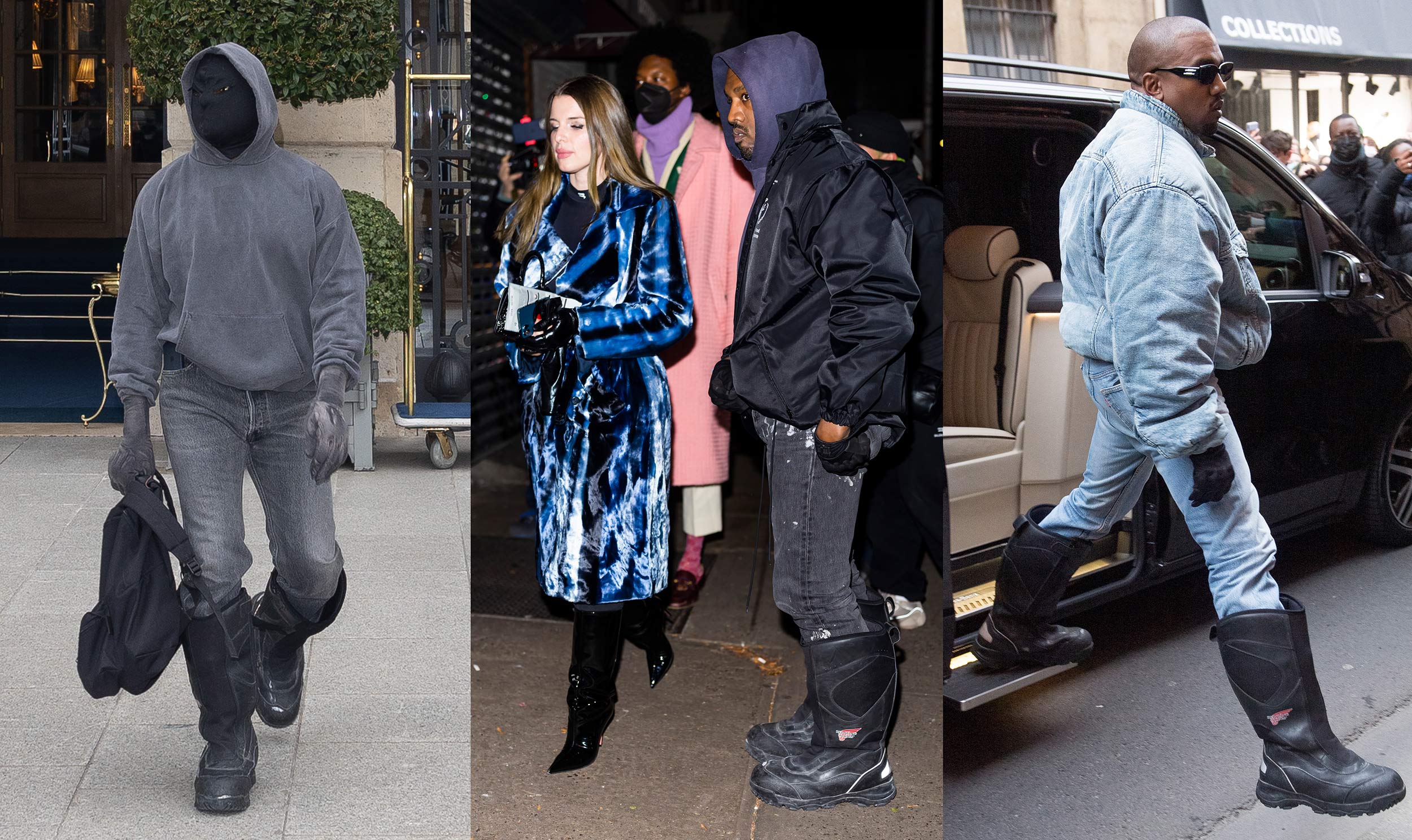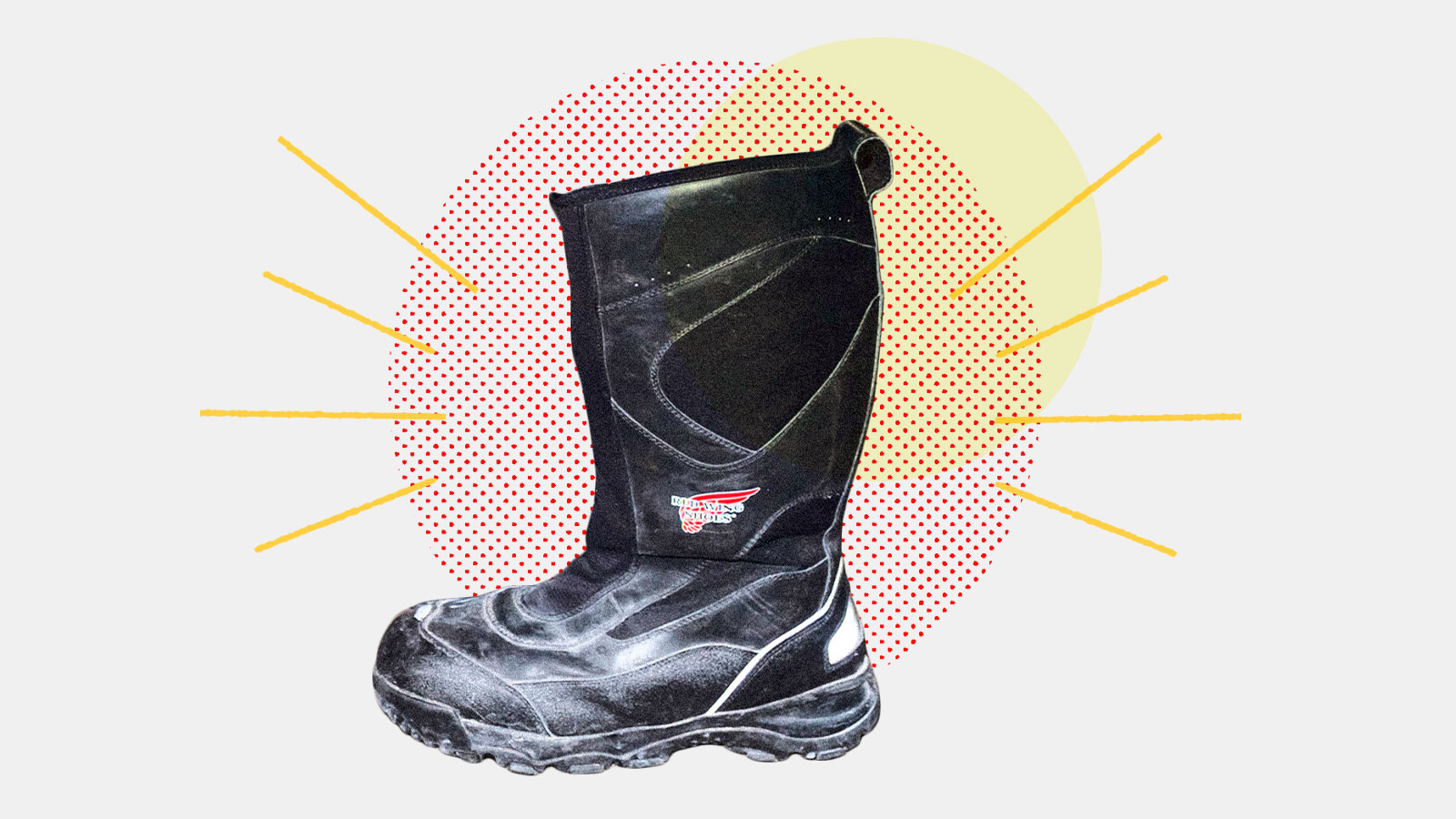If you spend a day at any gas station between Pittsburgh and Cincinnati, you are pretty much guaranteed to see a certain type of man. He steps down from a new pickup with 48 inch tires, and the feet that hit the ground are encased in heavy work boots: Ariats, Red Wings, or Wolverines. The boots are not clean, which is a point of pride, and he wears a heavy canvas jacket with reflective cuffs and collar over a large, worn-in hoodie. His purchase is usually Skoal and an energy drink in a neon-patterned can the size of a newborn. He is a likely candidate for a bar fight. He might object to this characterization, but he probably won’t.
In this extensively fracked corner of the country, this uniform signifies a particular identity: a man who works in oil and gas, and works hard. That made it somewhat surprising to see Kanye West repeatedly photographed over the past month in stiff, paint-flecked dungarees, a plain hoodie, and vintage Red Wing 3094 work boots. Dubbed “Spongebob boots” upon their debut at a benefit concert with Drake on December 10, the now-discontinued pair look like what you might imagine a fireman would wear on an emergency call to the North Pole, prompting my boyfriend to quip: “OSHA-approved, he could work night shift at the well.”

Less than a month later, the behemoth Red Wing boots were spotted again on a date with actress Julia Fox at the elite Italian restaurant Carbone – twice, at both the Miami and New York locations. Then again, alongside the runway at Paris couture week. They also made an appearance at a Los Angeles party with the confounding but high-net-worth guest list of Madonna, Floyd Mayweather, and Marilyn Manson.
The effect was predictable: Almost as soon as paparazzi photos of the distinguished SpongeBob boots hit the internet, a pair of the same model sold for $3,000 on Ebay. A week later, GQ published a list of more accessible lookalikes, including a “Dryshod NoSho Gusset XT Extreme cold-conditions hunting boot.” Shale country chic had entered the hypebeast awareness sphere.
West is not much of a pioneer here: sartorial trappings of heavy labor have been elevated to desirable streetwear by rappers and hip-hop stars who predate College Dropout by more than a decade. Jay-Z played a role in bringing Timberlands from construction sites to private rooms at Nobu. Snoop Dogg and Ice Cube paired $40 Dickies sets with $40,000 chains. Nas and Tupac’s fondness for Carhartt helped turn it into a brand that now does collaborations with Commes des Garçons’ Junya Watanabe.
But there is something novel about the recognizable specificity of the “Kanye boots,” which are now Googled to within an inch of their life. In 2013, the Wall Street Journal published an article on “frackwear, a new fashion that is unlikely to make the runways of Milan anytime soon.” (How young we once were!) The author went on to describe the investments that the owner companies of brands like Carhartt and Wrangler were making into garments that would meet the OSHA requirements of oil and gas drilling sites. They had to be flameproof and chemical-resistant, but light and flexible enough that you could still do heavy labor in them. They had to keep you warm in winter weather and visible when working hours extended well into night.
This piece was published in the ascent to the peak of an oil and gas boom that eventually – as they always do – came crashing down. Between 2015 and 2021, the number of employees in the oil and gas extraction industry plummeted from a peak of 200,000 to around 130,000, with the majority of that drop occurring in the one-year span between January 2016 and 2017. It is probably not a coincidence that during that year, Donald Trump devoted a lot of campaign rally time to rhapsodizing about the plight of the oil and gas worker, promising to bring back these hallowed American jobs. (That did not happen in any significant way.)
The romanticization of the rugged, “working class” man is hardly a new phenomenon, but this particular iteration of it is somewhat complex. The application of the term “working class” to someone who works in the fossil fuel industry is confusing, because oil and gas jobs tend to pay more than many office-bound positions, and significantly more than the types of service jobs that are available in extraction-heavy regions. As a wellhead pumper, which does not require a college degree, you could expect to earn around $62,000 a year, which is roughly 30 percent higher than the median American salary. And yet there is a vast amount of daylight between a pump operator’s salary and the yearly earnings of, say, Kanye West.
“Manly” remains a less controversial descriptor for the industry, at least in statistical terms; a McKinsey report found that the oil and gas industry has the lowest percentage of women employees in both entry and executive positions. But the industry also bears an undeniable mark of toxic masculinity, if you’ll permit an overused term. During that twenty-teens boom, a slew of reports came out on the very real hazards of concentrating thousands of young 20-something men with a lot of disposable income in tiny rural communities. Isolated boomtowns in Montana and North Dakota, notably, sustained brutal damage from the influx of rig workers and roughnecks: drug abuse, violence, and a whole spectrum of sexual offenses from harassment to sex trafficking to rape.
And yet, there is some strange preemptive nostalgia happening around the oil and gas worker in particular, and a lot of it is coming from people who have probably never set foot in a Boot Barn, be they Donald Trump or Justin Bieber. In September 2020, the latter released a music video to accompany his single “Holy,” wherein he played the role of an oil-smeared pipeline laborer let go from his job due to “the current and ongoing global situation.” It was not a particularly convincing performance.
Is it even possible to appropriate a professional identity? The local outfitters who serve employees of the oil and gas industry would have you think so – e.g., those who buy their chore coats at Work In Progress instead of Cabela’s are soft-handed poseurs who have never known a day of hard labor in their life. The Oil and Gas Safety and Supply & More Store, which has locations in Pennsylvania and Ohio, ran a contest in January to see which of its customers could bring in the “ugliest” boots – the filthiest, most beat-to-shit footwear from the field – and you will find dozens of men in the Facebook comments boasting that they are sure to win.
The American worker in the oilfield is so self-mythologized that it is, at this point, as much a persona as it is a reality. It is easy to make Nashville country songs and Hollywood films about a man on a rig. Less compelling is a romantic narrative around, say, an administrative assistant at an insurance firm or an Amazon warehouse stocker, both of which are far more representative of the American workforce. If you are employed in oil and gas, you adopt the character and wear the costume.
This brings us back to our friend Ye, who has been staging his own exaggerated reenactments of a certain genre of Americana for years. There was the Jumbotron proposal to Kim Kardashian in the San Francisco Giants’ stadium; the purchase of 11,000 acres of ranch property in Wyoming that is pure Bierstadt majesty; the assertion that to be a slave in the antebellum United States was “a choice”; and, of course, his trainwreck presidential campaign. The man adores a performance, and Americans love to be told a tale – we are a perfect, hideous match.



